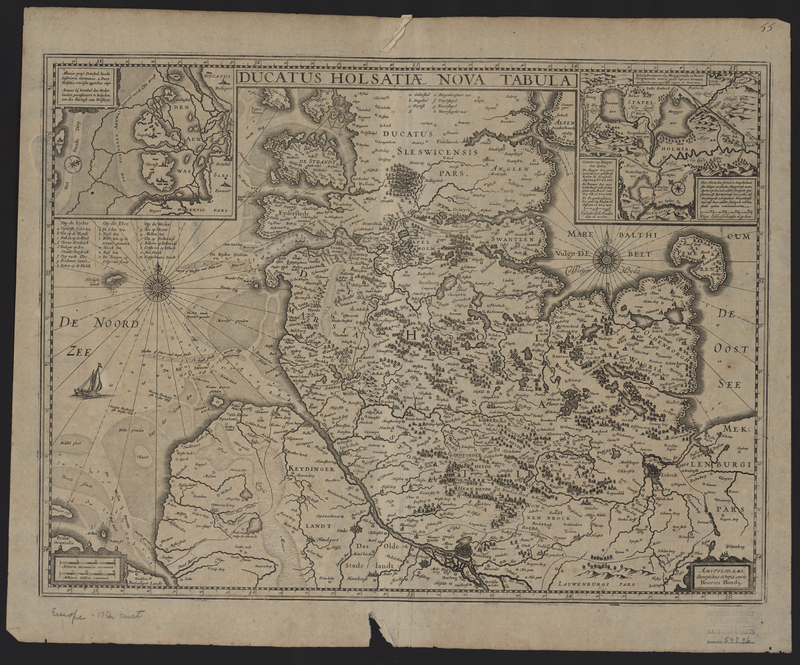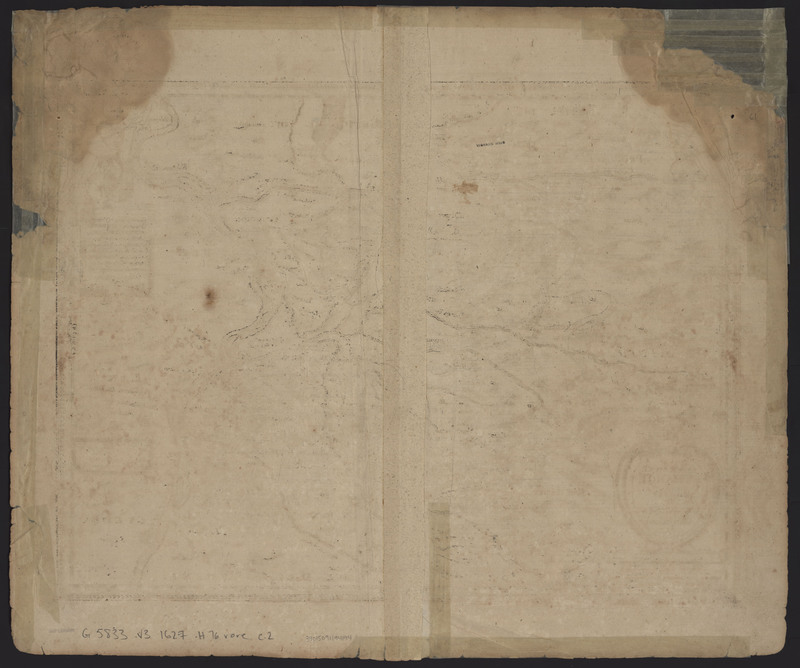Atlantis Maioris Appendix of 1630 (MS2)
The most exciting discovery made during the course of this project was the realization that one of our reassembled groupings matched an atlas, the Atlantis Maioris Appendix, published by Johannes Janssonius in 1630. There are only five known copies of this atlas in collections around the world. However, the edition found amongst Henry Vignaud’s maps, colloquially referred to as “Manuscript Style 2” or “Ms2,” is an exclusive copy that was compiled after 1634. Clark Library owns 35 of the 80 maps found in Janssonius’s Atlantis Maioris Appendix and the fifth map in the volume is owned by the William L. Clements Library, as well as possibly a second map from this volume.
At some point during the lifetime of these maps someone wrote manuscript numbers in the upper right corner of the versos. The sequence of these numbers matches the collation found in Peter van der Krogt’s description of the 1630 atlas in Koeman’s Atlantes Neerlandici.
There is one map in the Clark’s Atlantis Maioris Appendix that makes this set of maps unique from other editions of this atlas. The Clark copy includes the map Germaniae Post Omnes in hac Forma Editiones Exactissima Locupletissimaque Descriptio, which was printed in 1634. The inclusion of this map suggests that this particular group of maps was not produced and bound until somewhere after 1634.
This would not have been uncommon as atlases of time varied significantly. Publishing houses would produce piles of specific maps, which would be compiled into an atlas, sometimes by the design of the publisher and sometimes on request of a patron. When a certain map ran out, another of similar geographic area would replace it. It appears that this was the case for the Clark’s Atlantis Maioris Appendix.
As with the other reassembled atlases in Vignaud’s collections, certain environmental effects found on the maps help to differentiate this set from others and imply that the maps were bound together at some point during the course of their lifetimes. Fourteen of the maps found in this grouping bear significant water damage in the upper left and right corners of the maps.
The water damage was so extensive that it led to parts of the paper disintegrating and requiring considerable conservation care on some of the maps. Lesser extents of damage can be found throughout the remainder of the atlas. The water stains found throughout the atlas indicates that the maps were bound together at the time of damage. Similarly, a handful of the maps in the atlas bear the same type of staining that is found in Ms1, suggesting that these maps were stored vertically and closed when they were stained with mouse urine. However, the stains left behind are noticeably different than those found in Ms1.
Nova Europae Descriptio
Nova Europae Descriptio (Europe) was published in 1630 by Johannes Janssonius, and this is the only known case of the publication of this state. After Jodocus Hondius Jr. broke with his brother, he commissioned a new series of maps which were to be included in an atlas that Hondius planned to publish. These new maps featured borders composed of views of prominent cities and figures displaying local costumes. Unfortunately, Jodocus Hondius Jr. died unexpectantly in 1629, and the plates were sold by his widow to Willem Jansz. Blaeu, the Hondius family's competition. In 1630 Henricus Hondius and Johannes Janssonius made a contract with Evert Symonz. Hammersvelt and Salomon Rogiers to copy the plates that had been sold to Blaeu. Nova Europae Descriptio is an example of one of those plates that was copied. However, Jodocus Hondius Jr.'s name was not removed as the author of the map, so the map includes both Hondius's and Janssonius's name.
According to Peter Van der Krogt, the Nova Europae Descriptio was the first map in the Janssonius's Atlantis Maioris Appendix of 1630. In this atlas manuscript numbers are written in the upper right hand corner of the verso, and these number reflect the sequence laid out by Van der Krogt. However, the upper right corner is missing, making it impossible to say the original number definitively.
Germaniae...
Germaniae post omnes in hac forma editiones exactissima locupletissimaque descriptio (Germany) bears an inscription declaring that the map was engraved in 1634 by Claesz. Visscher. According to Van der Krogt a different map of Germany, entitled Nova Germaniae Descriptio by Johannes Janssonius, was incorporated into the original 1630 atlas. However, it was not uncommon that when a certain map ran out, another of similar subject would replace it in the atlas. At the same time, publishing houses would produce piles of specific maps, which would be compiled upon the request of a patron, which might be the case with this particular atlas.
Duche de Bretaigne
Duche de Bretaigne (Brittany, France) was engraved by Claude Hardy and originally published in 1630 by Henricus Hondius, but was also published in additional atlases until 1633. While the map was published by Henricus Hondius, it is not surprising to find it in an atlas by Johannes Janssonius. The two men published atlases together, as well as, individually. The map includes an inscription reading "et se vendent aussi a Paris chez Melchoir Tavernier demeurant sur l'Isle du Palais a la Sphere" (sold at chez Melchoir Tavernier located on the Isle du Palais in the Sphere). Melchoir Tavernier had a agreement with several Amsterdam cartographers which allowed him to sell the maps of Henricus Hondius, Johannes Janssonius, and Willem Blaeu in his Paris shop.
There are several distinguishing features of this map, including the manuscript "53" on the verso, which coincides with the sequence of maps in Johannes Janssonius's Atlantis Maioris Appendix of 1630. This particular map also bears evidence of significant water damage, which is visible in the top two corners. In an attempt to repair some of the damage done when the map was wet, a series of repairs were made.
La Principaute d'Orange...
La Principaute d'Orange et Comtat de Venaissin (Vaucluse, France) was originally published in 1630 and was republished in atlases until 1637. However, the title cartouche declares that the map was engraved in 1627. The additional cartouche in the upper right corner reveals that it was published by both Hondius brothers, Jodocus and Henricus, and the inscription in the bottom right corner details that the copper plate was engraved by Evert Symonz. Hamersvelt. Hamersvelt worked for both the Hondius brothers at different points in his career.
The map bears significant water damage, similar to that found on the Duche de Bretaigne (also found in this atlas). Due to the water damage the upper right corner of the verso is missing, meaning the manuscript number is missing as well. The map also features similar repairs to those found on the Duche de Bretaigne.

Appendix Atlas of 1636-1680 (Ms1)

Appendices of the British Isles and Northern Europe (Ms3)








